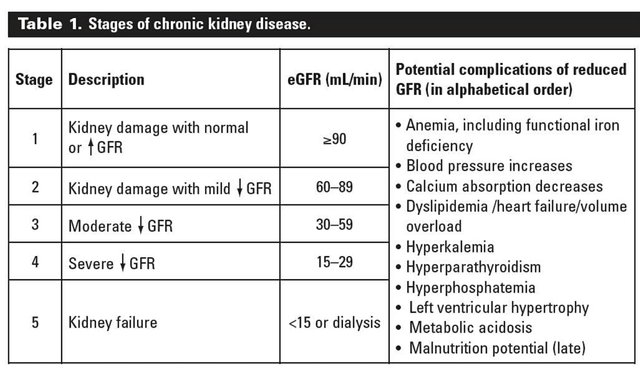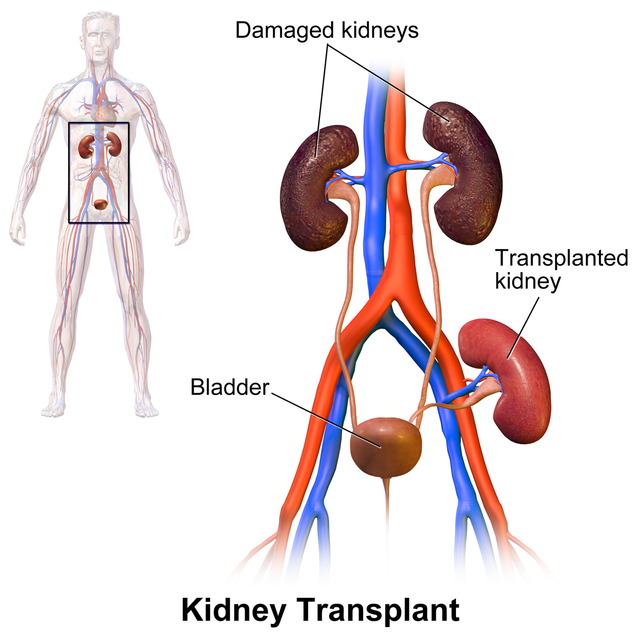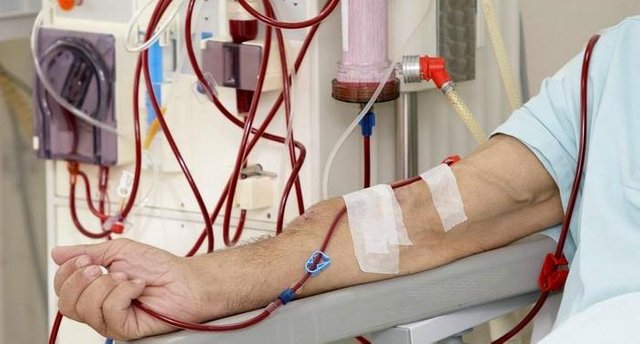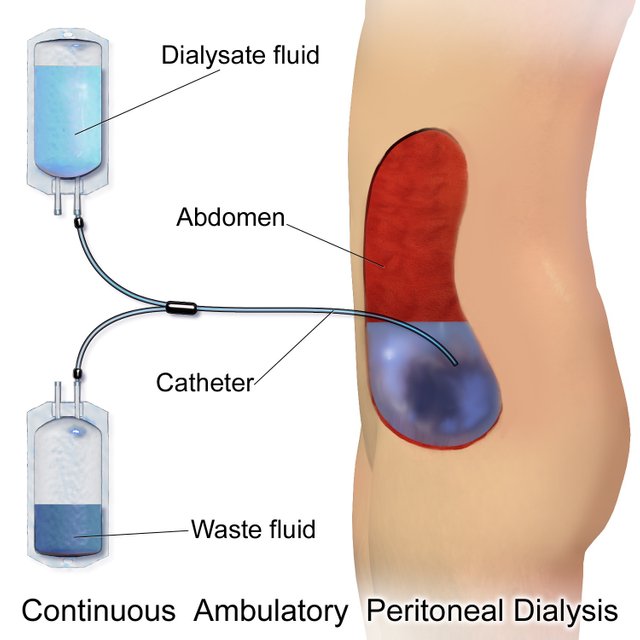Chronic Kidney Disease?
boldWhat is Chronic Kidney Disease?
Chronic kidney disease (CKD) is a progressive loss in kidney function over a period of months or years. Each of your kidneys has about a million tiny filters, called nephrons. If nephrons are damaged, they stop working. For a while, healthy nephrons can take on the extra work. But if the damage continues, more and more nephrons shut down. After a certain point, the nephrons that are left cannot filter your blood well enough to keep you healthy.
When kidney function falls below a certain point, it is called kidney failure. Kidney failure affects your whole body, and can make you feel very ill. Untreated kidney failure can be life-threatening.
What you should not forget:
Early chronic kidney disease has no signs or symptoms.
Chronic kidney disease usually does not go away.
Kidney disease can be treated. The earlier you know you have it, the better your chances of receiving effective treatment.
Blood and urine tests are used to check for kidney disease.
Kidney disease can progress to kidney failure.
Kidney Diseases are Common, Harmful and often Treatable
Common: Between 8 and 10% of the adult population have some form of kidney damage, and every year millions die prematurely of complications related to Chronic Kidney Diseases (CKD).
Harmful:
The first consequence of undetected CKD is the risk of developing progressive loss of kidney function that can lead to kidney failure (also called end-stage renal disease, ESRD) which means regular dialysis treatment or a kidney transplant is needed to survive.
The second consequence of CKD is that it increases the risk of premature death from associated cardiovascular disease (i.e. heart attacks and strokes). Individuals who appear to be healthy who are then found to have CKD have an increased risk of dying prematurely from cardiovascular disease regardless of whether they ever develop kidney failure.
Treatable: If CKD is detected early and managed appropriately, the deterioration in kidney function can be slowed or even stopped, and the risk of associated cardiovascular complications can be reduced.
How is kidney function measured?
The main indicator of kidney function is your blood level of creatinine, a waste product of the body produced by muscles and excreted by the kidneys. If kidney function is reduced, creatinine accumulates in the blood leading to an elevated level when a blood test is checked.
Kidney function is best measured by an indicator called GFR (Glomerular Filtration Rate) which measures the blood filtration rate by kidneys. This indicator allows doctors to determine if the kidney function is normal, and if not, to what level the reduced kidney function has deteriorated. In everyday practice, GFR can easily be estimated (eGFR), from measurement of the blood creatinine level, and taking into account, age, ethnicity and gender.
Stages of Chronic Kidney Disease (CKD)
Usually, kidney disease starts slowly and silently, and progresses over a number of years. Not everyone progresses from Stage 1 to Stage 5. Stage 5 is also known as End-Stage Renal Disease (ESRD).

bold****boldCauses of CKD
High blood pressure (hypertension) and diabetes are the most common causes of kidney disease. The high blood pressure causes just over a quarter of all cases of kidney failure. Diabetes has been established as the cause of around one-third of all cases and is the commonest cause of ESRD in most developed countries.
Other less common conditions include inflammation (glomerulonephritis) or infections (pyelonephritis). Sometimes CKD is inherited (such as polycystic disease) or the result of longstanding blockage to the urinary system (such as enlarged prostate or kidney stones).
Some drugs can cause CKD, especially some pain-killing drugs (analgesics) if taken over a long time. Often doctors cannot determine what caused the problem.
boldTreating CKD
There is no cure for chronic kidney disease, although treatment can slow or halt the progression of the disease and can prevent other serious conditions developing.
The main treatments are a proper diet and medications, and for those who reach ESRD, long term dialysis treatment or kidney transplantation. In the early stages of kidney disease, a proper diet and medications may help to maintain the critical balances in the body that your kidneys would normally control. However, when you have kidney failure, wastes and fluids accumulate in your body and you need dialysis treatments to remove these wastes and excess fluid from your blood, dialysis can be done either by machine (hemodialysis) or by using fluid in your abdomen (peritoneal dialysis). In suitable patients a kidney transplant combined with medications and a healthy diet can restore normal kidney function. Dialysis and kidney transplantation are known as renal replacement therapies (RRT) because they attempt to “replace” the normal functioning of the kidneys and are discussed in more detail below.
Peritoneal dialysis is another form of dialysis used to remove waste products and excess water. It works on the same principle as hemodialysis, but your blood is cleaned while still inside your body rather than in a machine by adding clean fluid to your abdomen, letting it accumulate waste products from the blood and then draining it out. It is typically done at home. Some patients can perform peritoneal dialysis continuously while going about normal daily activities (continuous ambulatory peritoneal dialysis, CAPD
boldKidney Transplantation
A kidney transplant is an operation to place a healthy (donor) kidney in your body to perform the functions your own diseased kidneys can no longer perform.
Kidney transplantation is considered the best treatment for many people with severe CKD because quality of life and survival are often better than in people who use dialysis. However, there is a shortage of organs available for donation. Many people who are candidates for kidney transplantation are put on a transplant waiting list and require dialysis until an organ is available.
A kidney can come from a living relative, a living unrelated person, or from a person who has died (deceased or cadaver donor); only one kidney is required to survive. In general, organs from living donors function better and for longer periods of time than those from donors who are deceased.
Overall, transplant success rates are very good. Transplants from deceased donors have an 85 to 90% success rate for the first year. That means that after one year, 85 to 90 out of every 100 transplanted kidneys are still functioning. Live donor transplants have a 90 to 95% success rate. Long-term success is good for people of all ages.
WKD 2012 was devoted to spreading the message about the importance of organ donation and kidney transplantation for people with ESRD.

boldDialysis
Healthy kidneys clean blood and remove extra fluid in the form of urine. They also make substances that keep our body healthy. Dialysis replaces the blood cleaning functions when kidneys no longer work.
There are two types of dialysis: hemodialysis and peritoneal dialysis.
In hemodialysis, your blood is pumped through a dialysis machine to remove waste products and excess fluids. You are connected to the dialysis machine through a needle in a vein that is surgically enlarged (vascular access) or through a temporary plastic catheter placed in a vein. This allows blood to be removed from the body, circulate through the dialysis machine for cleansing, and then return to the body. Hemodialysis can be done at a dialysis center or at home. When done in a center, it is generally done three times a week and takes between three and five hours per session. Home dialysis is generally done three to seven times per week and takes between three and ten hours per session (often while sleeping).

boldPrevalence of CKD
About 1 in 10 people have some degree of CKD. It can develop at any age and various conditions can lead to CKD.
Kidney disease can affect people of all ages and races. African Americans, Hispanics, American Indians and people of South Asian origin (those from India, Bangladesh, Sri Lanka or Pakistan) have a higher risk of CKD. This risk is due in part to high rates of diabetes and high blood pressure in these communities.
CKD can occur at any age, but r becomes more common with increasing age and is more common in women. Although about half of people aged 75 or more have some degree of CKD, many of these people do not actually have diseases of their kidneys; they have normal ageing of their kidneys. Simple blood and urine tests can detect CKD and simple, low cost treatments can slow the progression of the disease, reduce the risk of associated heart attacks and strokes and improve quality of life.
Cost of CKD
The prevalence of kidney disease is increasing dramatically and the cost of treating this growing epidemic represents an enormous burden on healthcare systems worldwide. Even in high income countries, the very high cost of long term dialysis for increasing numbers of people is a problem. In low and middle income countries long term dialysis is unaffordable. The best hope for reducing the human and economic costs of chronic kidney disease and end-stage renal disease therefore lies in prevention, for the following reasons:
Chronic kidney diseases are not curable and can cause people to need care for the rest of their lives.
If CKD is not detected early enough, the patient may progress to kidney failure which requires Renal Replacement Therapy (dialysis or transplantation) that is extremely costly and weighs heavily on healthcare budgets.
Chronic Kidney Diseases trigger other healthcare issues like cardiovascular diseases (heart attack and stroke), which will lead to premature death or disability and multiply the amount of amount of money needed for the healthcare of a patient.
In developed countries, ESRD is a major cost driver for patients, their families and the taxpayer. Patients with ESRD require dialysis or kidney transplantation, which are highly costly and consume a sizeable portion of the health budget.
For instance:
According to a recent report published by NHS Kidney Care, in England Kidney Disease costs more than breast, lung, colon and skin cancer combined.
In Australia, the cost of treating all current and new cases of ESKD to 2020 is estimated at $12 billion. The annual cost of dialysis per patient per year varies between 50,000 and 80,000 AUD depending on the type of treatment.
In the US, treatment of CKD (…) is likely to exceed $48 billion per year, and the ESRD program consumes 6.7% of the total Medicare budget to care for less than 1% of the covered population.
In China, the economy will lose US$558 billion over the next decade due to effects on death and disability attributable to chronic cardiovascular and renal disease.
In Uruguay, the annual cost of dialysis is close to $ US 23 million, representing 30% of the budget of the National Resources Fund for specialized therapies.
In middle-income countries, access to life-saving therapies has progressively increased over the same period yet renal replacement therapy remains unaffordable for the majority of patients.
Developing countries, with a combined population of over 600 million people, cannot afford renal replacement at all—resulting in the death of over 1 million people annually from untreated kidney failure. Indeed, more than 80% of individuals receiving renal replacement therapy (RRT) live in the developed world because in developing countries it is largely unaffordable. In countries such as India and Pakistan, less than 10% of all patients who need it receive any kind of renal replacement therapy. In many African countries there is little or no access to RRT, meaning many people simply die. RRT is also used to treat acute kidney injuries where recovery of kidney function usually occurs if the patient can be kept alive by dialysis until that happens. The lack of available RRT results in the preventable deaths of many thousands of children with diarrheal diseases and women with complications of pregnancy in the developing world every year (see below). WKD 2013 was dedicated to spreading the message of the importance of acute kidney injury (AKI).
Examples of costs from other regions of the world: http://www.academia.edu/3633811/Chronic_kidney_disease_global_dimension_and_perspectives
bold
CKD in elderly people
About 1 in 10 people have some degree of CKD. It can develop at any age and various conditions can lead to CKD. It however becomes more common with increasing age. After the age of 40, kidney filtration begins to fall by approximately 1% per year. On top of the natural aging of the kidneys, many conditions which damage the kidneys are more common in older people including diabetes, high blood pressure and heart disease.
It is estimated that about one in five men and one in four women between the ages of 65 and 74, and half of people aged 75 or more have CKD. In short, the older you get the more likely you are to have some degree of kidney disease. This is important because CKD increases the risk of heart attack and stroke, and in some cases can progress to kidney failure requiring dialysis or transplantation. Regardless of your age, simple treatments can slow the progression of kidney disease, prevent complications and improve quality of life.
Thanks you
hopefully useful
Reference : please visite http://www.worldkidneyday.org/faqs/chronic-kidney-disease/
